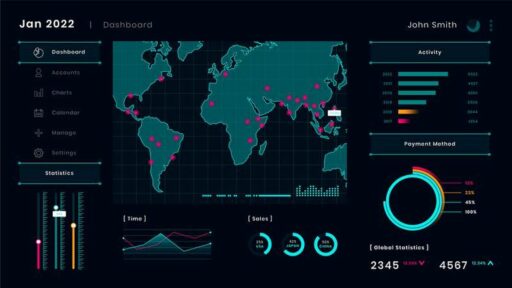Table of Contents
Quantitative data is a cornerstone of empirical research, providing a numerical foundation for understanding various phenomena. It is essential for researchers who wish to quantify aspects of their study, offering clear, measurable, and objective data points that can be statistically analyzed. This article delves into the nature of quantitative data, its collection and analysis, and its critical role in decision-making processes across different fields.
Key Takeaways
- Quantitative data is numerical information that is used for statistical analysis to answer questions like ‘what’, ‘how many’, and ‘how often’.
- It differs from qualitative data, which is descriptive and categorized by themes, providing insights into the ‘why’ behind phenomena.
- Quantitative data is pivotal in areas such as conversion optimization, product management, UX design, and more, where measurable outcomes are essential.
- The collection and analysis of quantitative data involve using various tools and methods to ensure accuracy, reliability, and meaningful interpretation.
- Integrating quantitative data with qualitative data offers a comprehensive understanding of user behavior, enhancing decision-making and user experience.
The Essence of Quantitative Data


Defining Quantitative Data
Quantitative data is fundamentally about numbers and values. It encompasses any information that can be quantified, meaning it can be counted or measured and expressed numerically. Quantitative data is essential for statistical analysis and mathematical calculations, providing a basis for answering questions like ‘how much,’ ‘how many,’ and ‘how often.’
Quantitative data can be categorized into two main types: discrete and continuous. Discrete data represents items that can be counted and have a finite number, while continuous data can take on any value within a range. Here’s a simple table illustrating some common quantitative data examples:
| Data Type | Examples |
|---|---|
| Revenue | Dollars |
| Weight | Kilograms or Pounds |
| Age | Years or Months |
| Distance | Miles or Kilometers |
| Time | Days or Weeks |
Quantitative data is distinct from qualitative data, which is descriptive and characterized by thematic categorization rather than numerical expression. While quantitative data provides the ‘how much,’ qualitative data offers the ‘what kind’ or ‘which category.’
In practice, quantitative data is indispensable in various fields, from scientific research to business analytics, where precise measurements and statistical evidence drive decision-making processes.
Quantitative vs. Qualitative Data
Understanding the distinction between quantitative and qualitative data is crucial for researchers and analysts. Quantitative data is numerical, easily measured, and can be expressed in statistics and graphs. In contrast, qualitative data is descriptive, often textual or visual, and captures the nuances of ‘why’ and ‘how’.
Quantitative data excels in identifying patterns and trends through statistical analysis. It’s the backbone of empirical research, providing measurable evidence that supports concrete conclusions. On the other hand, qualitative data delves into the depth of experiences, motivations, and meanings, offering rich insights that numbers alone cannot convey.
The choice between quantitative and qualitative data should be driven by the research question. Quantitative methods answer ‘how much’ or ‘how often’, while qualitative methods explore the underlying reasons and motivations.
Here’s a simple comparison to illustrate the differences:
| Aspect | Quantitative Data | Qualitative Data |
|---|---|---|
| Nature | Numerical, measurable | Descriptive, thematic |
| Focus | Quantity, frequency, patterns | Meaning, experience, understanding |
| Methodology | Surveys, experiments, statistics | Interviews, focus groups, analysis |
| Outcome | Statistical evidence, trends | Thematic insights, narratives |
In practice, both types of data are valuable and often complementary. While quantitative data provides the statistical backbone, qualitative data adds context and depth, enriching the overall understanding of a subject.
Real-World Applications and Examples
Quantitative data plays a pivotal role across various sectors, providing a foundation for evidence-based decision-making. In education, for instance, quantitative metrics such as test scores and graduation rates offer insights into the effectiveness of teaching methods and curricula. Similarly, in healthcare, patient recovery rates and medication adherence statistics are crucial for evaluating treatment outcomes and improving care protocols.
In the realm of STEM education, quantitative data is instrumental in assessing the impact of programs on students’ practical application understanding and problem-solving skills. The following table summarizes key metrics in this field:
| Metric | Description |
|---|---|
| Practical Application Understanding | Grasp of theoretical concepts in real-world scenarios. |
| Problem-solving Skills | Improvement in students’ abilities to tackle complex problems post-program. |
Quantitative data not only informs but also transforms practices by highlighting areas for improvement and success.
Public datasets, such as those from the Bureau of Labor Statistics or the World Bank, offer a wealth of quantitative data for analysis. Researchers can leverage this data to draw conclusions relevant to their own projects without the need for original data collection. This approach underscores the versatility and accessibility of quantitative data in research.
Collecting and Measuring Quantitative Data


Methods of Data Collection
Quantitative data collection is a fundamental aspect of research, providing the numerical foundation for evidence-based conclusions. Surveys and experiments are structured methods that are particularly effective for gathering this type of data. They are designed to answer questions about frequency, quantity, and degree, using mathematical models and statistical techniques for subsequent analysis.
When selecting the right data collection method, it’s crucial to align with your research objectives. The choice of method can significantly influence the insights you gain and the decisions you make. For instance, surveys can offer a broad understanding of trends, while experiments can establish cause-and-effect relationships.
Deciphering the best data collection method is essential for making your data work smarter and achieving comprehensive insights.
Here are some common quantitative data collection methods:
- Surveys and Questionnaires
- Experiments
- Observational Studies
- Document Study
- Diaries, Logs, or Journals
Tools for Measuring and Tracking
In the realm of quantitative data, the tools we use to measure and track metrics are pivotal. Data analytics tools such as Google Analytics, social media insights, and email marketing platforms are at the forefront of this process, providing a wealth of data that can be harnessed for insightful analysis.
To effectively utilize these tools, it’s essential to:
- Understand the capabilities and features of each tool.
- Set benchmarks for success, using historical data or industry standards.
- Regularly monitor and adjust strategies based on data insights.
By setting clear benchmarks and regularly reviewing data, organizations can ensure they are on the path to achieving their goals.
Additionally, the integration of product analytics tools can quantify user experiences for ongoing improvement. These include:
- Tagless Autocapture
- Frustration Signals
- Funnels & Conversions
- Journey Mapping
- Dashboards
- User Segments
Moreover, session insights like Session Replay and Heatmaps provide qualitative context, which is crucial for understanding the user experience in depth.
Ensuring Data Accuracy and Reliability
Ensuring the accuracy and reliability of quantitative data is paramount to the integrity of any analysis. Data cleaning is a critical step in this process, involving the removal of duplicates, noise, and irrelevant data points that can skew results. This foundational task sets the stage for more accurate and meaningful insights.
Data cleaning not only saves time in subsequent analysis steps but also guarantees that decisions are made based on relevant and high-quality data.
Validation and triangulation are additional practices that bolster data reliability. Validation involves cross-referencing data points with established benchmarks or known values, while triangulation means comparing data from multiple sources to confirm consistency. Here are some common pitfalls to avoid during data exploration:
- Overemphasizing data alone without considering broader project implications.
- Confusing correlation with causation, which can lead to incorrect assumptions.
- Failing to document the process, which is crucial for replicating and verifying results.
By meticulously cleaning data, validating findings, and documenting each step, researchers can ensure that their quantitative data is both accurate and reliable, forming a solid foundation for any subsequent analysis.
Analyzing Quantitative Data


Statistical Analysis Techniques
Statistical analysis in quantitative research is pivotal for transforming raw data into actionable insights. Descriptive statistics serve as the foundation, summarizing data through measures such as mean, median, mode, and standard deviation. These summary statistics are crucial for understanding central tendencies, variability, and identifying unusual data points or clusters.
Inferential statistics, on the other hand, allow researchers to make predictions or inferences about a population based on a sample. This branch of statistics utilizes probability theory to test hypotheses and determine the likelihood of certain outcomes.
The choice of statistical methods depends on the research objectives and the nature of the data. For instance, chaotic data may require more complex analytical approaches beyond basic descriptive statistics. The table below outlines some common statistical techniques and their applications:
| Technique | Description | Application |
|---|---|---|
| Mean | Average value | Central tendency |
| Median | Middle value | Central tendency |
| Mode | Most frequent value | Central tendency |
| Standard Deviation | Measure of variability | Data dispersion |
Summary statistics not only describe the data but also lay the groundwork for further analysis, such as trend identification and pattern recognition. They are instrumental in both descriptive and inferential statistical methods.
Interpreting Numbers and Trends
Interpreting quantitative data effectively is crucial for uncovering actionable insights. Identifying trends and patterns in data allows organizations to make informed decisions. For instance, website visitor statistics can reveal shifts in user behavior, popular content, and traffic sources over time. By examining these metrics, businesses can optimize their online presence and marketing strategies.
When analyzing website data, it’s important to consider various indicators. Here’s a succinct table showcasing key website metrics and their potential implications:
| Metric | Implication |
|---|---|
| Unique Visitors | Health of website traffic |
| Pageviews | Content popularity |
| Bounce Rate | User engagement level |
| Conversion Rate | Effectiveness of calls-to-action |
A sudden increase in bounce rate, for example, might signal a user experience issue, prompting a need for website optimization. Similarly, demographic data can inform targeted marketing efforts, ensuring messages reach the appropriate audience segments.
Regular monitoring and adaptation to these insights can significantly improve a website’s performance and user experience.
Comparing data over time is essential to gauge the effectiveness of marketing campaigns or website changes. Directional indicators, such as whether metrics are improving or declining, provide a snapshot of a company’s trajectory and can guide strategic adjustments.
Making Data-Driven Decisions
In the realm of data-driven decision-making, the reliance on quantitative data transcends guesswork, providing a solid foundation for strategic choices. Metrics serve as a beacon, guiding businesses through the complexities of the market and illuminating the path to success.
Enhanced decision-making is a pivotal advantage of data analytics. Well-designed data visuals can communicate the implications of various decisions, offering insights into potential outcomes.
Here are common considerations when making data-driven decisions:
- Ensuring that data-based insights are reliable and relatable to specific teams.
- Recognizing that input A does not always yield output B and considering a spectrum of potential outcomes.
- Balancing data with other factors, as overemphasizing data alone can lead to oversight of important qualitative aspects.
Embrace the power of metrics, and watch as your data-driven decisions propel your business to new heights of success. Remember, while data informs, it is the nuanced understanding of that data which ultimately drives effective decision-making.
Quantitative Data in Decision Making


Influence on Product Management and UX Design
In the realm of product management and UX design, quantitative data serves as a compass, guiding decisions with empirical evidence. Quantitative research methods are pivotal in understanding user behavior and optimizing product features. For example, by analyzing metrics such as time on page, click-through rates, and conversion percentages, teams can pinpoint areas for improvement.
Quantitative data also plays a crucial role in user testing scenarios. By setting up A/B tests and monitoring user interactions, designers can make data-driven changes that enhance the user experience. Consider the following table summarizing key metrics from a hypothetical A/B test:
| Metric | Variant A | Variant B |
|---|---|---|
| Time on Page (avg.) | 2 min | 3 min |
| Click-through Rate (%) | 5% | 8% |
| Conversion Rate (%) | 1.5% | 2.2% |
Quantitative data not only informs design choices but also validates them, ensuring that changes lead to tangible improvements in user engagement and satisfaction.
The integration of quantitative data into product management and UX design is not just about numbers; it’s about understanding the user journey and making informed decisions that resonate with the target audience. By leveraging both quantitative and qualitative insights, teams can create more intuitive and user-friendly products.
Optimizing Conversion Rates
Optimizing conversion rates is a critical aspect of leveraging quantitative data for business success. Conversion rate optimization (CRO) is the process of increasing the percentage of users who perform a desired action on a website. This could be making a purchase, signing up for a newsletter, or completing a contact form. By analyzing quantitative data, businesses can identify areas where users drop off and test changes to improve the conversion funnel.
Key metrics play a pivotal role in understanding and enhancing conversion rates. Here’s a succinct table showcasing some of these metrics:
| Metric | Description |
|---|---|
| Conversion Rate | The percentage of visitors who take the desired action. |
| Click-Through Rate (CTR) | The ratio of users who click on a specific link to the number of total users who view a page, email, or advertisement. |
By focusing on these metrics, businesses can systematically approach CRO, making informed decisions that can lead to significant improvements in revenue and customer engagement.
It’s important to remember that while quantitative data provides the ‘what’ and ‘how much’, it is the qualitative insights that often explain the ‘why’ behind user behavior. Balancing both types of data ensures a comprehensive understanding of the customer journey.
Balancing Quantitative Insights with Qualitative Context
While quantitative data is invaluable for measuring and tracking trends, it can sometimes miss the nuances of human behavior and motivation. Qualitative data, on the other hand, provides the context and depth needed to fully understand the ‘why’ behind the numbers.
By integrating qualitative insights, decision-makers can interpret quantitative data within the framework of human experience, leading to more empathetic and user-centric solutions.
In practice, balancing these insights often involves a series of steps:
- Collect quantitative data to establish a baseline of metrics.
- Gather qualitative feedback to explore the reasons behind the metrics.
- Analyze the quantitative data for patterns and trends.
- Use qualitative data to add narrative and meaning to those patterns.
- Make informed decisions that are grounded in data but enriched by human context.
This approach ensures that data-driven decisions are not only statistically sound but also resonate with the target audience on a deeper level.
Integrating Quantitative and Qualitative Research


The Complementary Nature of Data Types
In the realm of data analysis, the integration of quantitative and qualitative data is pivotal for a comprehensive understanding. Quantitative data provides the hard numbers and statistical evidence, while qualitative data offers context and depth to those numbers. This synergy allows for a more nuanced interpretation of data, ensuring that the limitations of one type are balanced by the strengths of the other.
Quantitative data is characterized by its numerical nature, allowing for operations such as addition and subtraction. It is often categorized into discrete and continuous data, with continuous data further divided into interval and ratio data. Here’s a simple breakdown:
| Data Type | Description | Example |
|---|---|---|
| Discrete | Countable, separate units | Number of users |
| Continuous – Interval | Numeric without true zero | Temperature (Celsius) |
| Continuous – Ratio | Numeric with true zero | Height in centimeters |
Qualitative data, on the other hand, is less structured but equally important. It includes categorical data and examples that provide insights into the ‘why’ and ‘how’ behind the numbers. When combined, these data types enhance the evaluation process, leading to more informed decision-making.
By embracing both quantitative and qualitative research, analysts can deliver a richer, more accurate narrative that resonates with both the logical and emotional aspects of human decision-making.
Case Studies: When to Use Which
Deciding between qualitative and quantitative research often hinges on the nature of the data needed and the goals of the study. Quantitative data excels in providing statistical insight, while qualitative data offers depth and context.
In a healthcare setting, quantitative data might track symptom reduction, while qualitative data captures patient narratives.
For instance:
- A healthcare organization may use qualitative methods to document patient experiences with a new treatment, providing rich context for quantitative outcomes.
- A tech company might conduct in-depth interviews to understand user experiences with a new product, which can reveal usability issues not evident in quantitative data alone.
In some cases, a mixed-methods approach is beneficial:
- Parallel Investigation: Collecting both numerical data and patient narratives to assess a treatment’s impact.
- Data Transformation: Converting numerical survey responses into categories for a nuanced interpretation.
Choosing the right method can significantly enhance the understanding of the subject matter, whether it’s for improving treatments or refining a product.
Enhancing User Experience with Mixed Methods
In the realm of user experience, the integration of quantitative and qualitative research methods can lead to a more comprehensive understanding of user behavior. Quantitative data lays the groundwork by providing measurable insights, while qualitative data adds depth by revealing the user’s motivations and feelings.
For example, a UX team may start with quantitative data to pinpoint areas where users are dropping off in an app. This data might show a high exit rate on a particular screen. To understand why users are leaving, the team would then conduct qualitative research, such as user interviews or focus groups.
By triangulating data from different sources, teams can create a robust strategy that addresses both the what and the why behind user actions.
The sequential approach to mixed methods research—quantitative followed by qualitative—allows teams to first identify issues at a broad level and then delve into the specifics. This method ensures that optimization efforts are not only data-driven but also empathetically aligned with user needs.
Conclusion
In the exploration of quantitative data, we’ve unveiled its essence as the numerical backbone of empirical analysis. Quantitative data stands out for its ability to be counted, measured, and applied to statistical models, providing clear, objective insights into various phenomena. Whether it’s tracking product adoption rates, analyzing conversion metrics, or measuring user engagement, quantitative data offers a concrete foundation for decision-making. While it may not capture the subjective nuances of human experience like qualitative data, its strength lies in its precision and the capacity to answer ‘what,’ ‘how many,’ and ‘how often.’ As we continue to navigate an increasingly data-driven world, the mastery of quantitative data becomes essential, enabling us to quantify complexities and make informed decisions based on empirical evidence.
Frequently Asked Questions
What is quantitative data?
Quantitative data is information that can be counted or measured, given a numerical value, and used to quantify a problem, answering questions like ‘what,’ ‘how many,’ and ‘how often.’
How does quantitative data differ from qualitative data?
Quantitative data is numerical and can be definitively counted or measured, while qualitative data is descriptive, expressed in words or visuals, and categorized according to themes.
What are some real-world applications of quantitative data?
Quantitative data is used in various fields such as conversion optimization, product management, and UX design, providing statistical insights into user behavior, product adoption rates, and other measurable factors.
Why is quantitative data important in decision-making?
Quantitative data provides objective metrics that can influence product management, optimize conversion rates, and guide data-driven decisions, balancing numerical insights with qualitative context.
Can quantitative data be used alone to understand user behavior?
While quantitative data offers measurable insights into user behavior, combining it with qualitative data provides a deeper understanding of the motivations and reasons behind user actions.
What are the benefits of integrating quantitative and qualitative research?
Integrating quantitative and qualitative research allows for a comprehensive understanding of an audience, combining numerical trends with contextual depth to inform optimizations and enhance user engagement.





